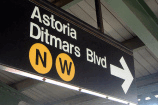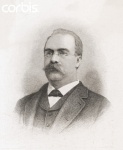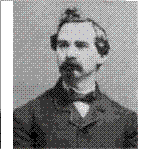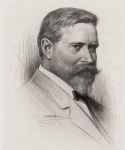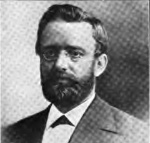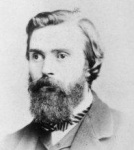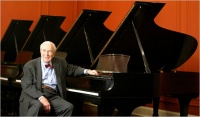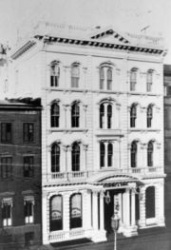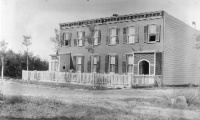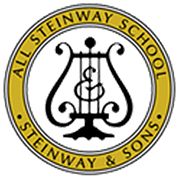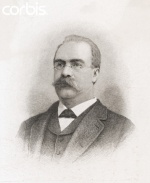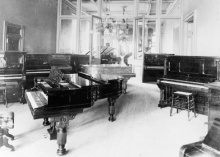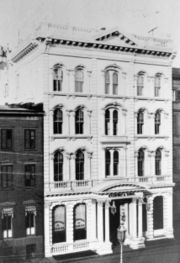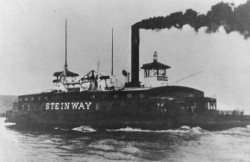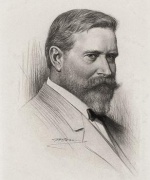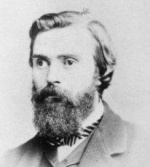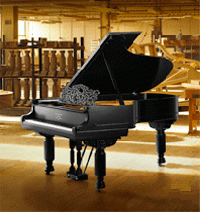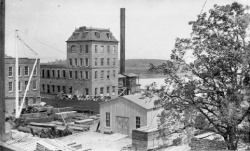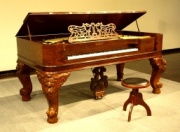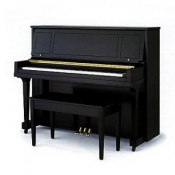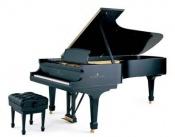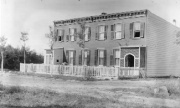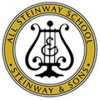| wiki | search |
Home
| Population Trends
| Gentrification
| Culinary Demography
| Architecture
Houses of Worship
| Art in Astoria
| Film Industry
| Steinway
| Index
| Contributors
| Well-known as a top-notch piano brand in the music world, Steinway is also a neighborhood of Astoria with its own subway line (named Steinway as well). The factory and office are located in Astoria at the northeastern end of Steinway Street. Blue: Astoria region |
View Astoria and Steinway & Sons in a larger map
|
| First Generation | |||||
|---|---|---|---|---|---|
| Second Generation | |||||
| Last Generation | |||||
| 19th Century | |||
|---|---|---|---|
| 20th Century & Beyond |
Steinway Family
Heinrich Engelhard Steinweg (1797-1871)
Life in Germany
Born on February 5, 1797 in Wolfshagen, Germany, not much is known about Henry Steinway's childhood except what family tradition has left behind. According to that tradition, Steinway was the youngest of twelve children and was his family's sole survivor at age fifteen. The rest of his family were either killed in the wars of the time or from diseases and natural disasters.[1]
Henry Steinway had little to no schooling; however, he was gifted with an ability to commit music to memory. Discovered during his time in the army, Steinway decided to build a cithara, a variation of the lyre, in order to lighten the rigid life of a soldier and to accompany his brigade's singing of patriotic songs. He was able to play almost any melody after having heard it sung once.[2]
In 1818, Steinway chose to leave the army and made for Goslar in central Germany to specialize as a cabinetmaker. However, the craft of cabinetmaking came under guild regulation which forces crafters to undergo a long period of training. Instead of committing himself to this, Steinway decided to learn how to build church organs, a craft not under the scrutiny of the guilds.[2]
There are no certain records of when and where Steinway began to manufacture pianos. According to Albert Bernhardt Faust, the historian of the German-American community, Steinway opened his piano factory in Brunswick in 1825. Another story claims that Steinway built his first piano in the family kitchen in 1836. What is certain is that Steinway's creations received first prize at the Brunswick State Fair in April 1839.[3]
Immigration
The Steinway family was part of a large wave of Italian and German immigrants that came to the United States during the mid-19th century.
Charles Steinway was the first of the family to immigrate to the United States in 1849. He moved because of the hostile political climate in Germany towards liberals during that time. [4]
In 1850, having sold his home and factory, Henry Steinway took his family to Hamburg, with the exception of C.F. Theodore Steinway who stayed behind and opened his own piano factory, where they sailed for New York City. One of the reasons they immigrated was because of Charles convinced them to come. They also came to seek a better business environment since the town they were in offered too little opportunities to grow.[3]
They arrived on June 29, 1850 and settled in a tenement at 199 Hester Street in the Lower East Side. This section of lower Manhattan contained some 15,000 German families which accounted for two-thirds of the German population of New York.[3]
Life in the United States
Upon coming to America, Heinrich Steinweg changed his name to Henry Steinway. He-- along with three of his sons, Henry Jr., Albert, and Charles-- went to work for a piano manufacturer named Bacon & Raven.[5] Eventually, Steinway opened up a piano business of his own that would become the Steinway & Sons of today.
William Steinway (1836-1896)
Born in Seesen in 1836 as the fifth son of Henry Steinway, William Steinway was a visionary and one who struck out to do many things. He became the first president of Steinway & Sons and skillfully managed the day-to-day affairs of the company. William was also the driving force in expanding the company's reputation through various marketing techniques such as sponsoring concerts, supplying prominent artists such as Richard Wagner with pianos, and using famous people such as Thomas Edison and Czar Alexander II to convince prospective customers of Steinway's quality and brand-name. Investing in newspaper and magazine ads, William had a hand in expanding the market share of the company.[6]
Accomplishments
Beyond running the daily operations of Steinway & Sons, Steinway also looked out for the long-term health of the company and its employees. In the process, he "set up a land company, a streetcar line, and a ferry in connection with the firm's Long Island operations."[7] He contributed to the creation of New York's first subway system and served a term as chairman of the Rapid Transit Commission. Steinway also publicized the Daimler Motor Company in America after entering into a partnership with Gottlieb Daimler in Germany.[7]
Steinway Hall
Steinway's most ambitious project was the construction of Steinway Hall, originally located at East 14th Street in New York. It was a place that would serve as an advertising as well a performance center for artists and the general public. After the hall was first opened on October 31, 1866 until 1890, it became one of New York's leading cultural centers, serving as the home of the New York Philharmonic and as a forum for public meetings.[8]
In 1890, Steinway Hall was "superseded by Carnegie Hall as the city's principal concert auditorium." [9] Later on in 1925 a new Steinway Hall opened on West 57th Street, across the street from Carnegie Hall.
Transportation
Some of the reasons for Steinway's investment in the transportation system was to "attract and retain skilled workers" and "well-to-do refined people" to Steinway Village.[10]
Initially, Steinway bought bonds in the Long Island Shore Railroad to extend its tracks to Steinway. Soon after, Steinway became invested in the building of a bridge across the East River that would connect Long Island to upper Manhattan. However, the fundraising fell short of what was needed at the time and his vision, what is now known as "the Queensborough Bridge, was not completed until 1909."[11]
Another transportation venture Steinway was involved in was replacing horse-car railroads with a different power source and connecting the railroads to ferry stations to "close the distance between New York and Long Island City." He used the Rikers power plant to electrify these cars and "thus, Astoria became one of the nation's first areas to be equipped with trolley cars."[11]
Completed in 1933, Steinway Street Station is located at Steinway Street and Broadway, Long Island City. It was named after William Steinway to honor him, the community that he built and the vision he had. [7]
Christian Friedrich Theodore Steinway (1825-1889)
The oldest son of Henry Steinway, Theodore Steinway amassed more than 40 patents in Germany and was one of the major innovators in the piano industry. He particularly disliked America. However, with the death of both Henry Steinway, Jr. and Charles Steinway in March 1865, Theodore was forced to sell the factory he built in 1859 and come to America to support the business.[12]
In America, he became the company's scientific director. Along with many skilled workers he brought with him from Germany, Steinway worked on an improved upright piano which would combine "power, full tone, and an even register with a durable action." Such a creation proved to be highly popular with American consumers. "By 1883 half the pianos sold in America were uprights."[12]
Theodore Steinway also served on the Committee of Seventy which investigated the Tweed Ring in 1871, "the most scandalous corruption in the history of New York."[13]
Albert Steinway (1840-1877)
Born on June 10, 1840, Albert Steinway was the youngest son of Henry Engelhardt. Similar to his brothers, Albert chose piano making as his line of work and following the death of Charles Steinway gained the management of the factories.
Albert studied the application of machinery for manufacturing modern heating and lighting systems, thus keeping the Steinway factories as the front of progressive industrial establishments. The development of the village of Steinway was mainly his work as well as the planning and erection of the sawmills, iron foundry, metal shops, and case factory.[14] It was also Albert who patented the overstrung grand piano on December 20, 1859.[15]
However, with his relentless work trying to accomplish in a given time more than his bodily strength would allow proved detrimental to Albert's already weak constitution and thus he died at the age of 37 on May 14, 1877.[14]
Henry Steinway, Jr. (1831-1865)
Henry Steinway, Jr. created the overstrung grand piano, "the first great Steinway invention." He also believed in and had plans for use of musicians' endorsements, one of the key strategies that made Steinway's name famous in the world.[16]
Nevertheless, he was unable to see his plans to fruition because of his sudden death. The final plans were completed by William Steinway in the form of hosting concerts at Steinway Hall where musicians had a place to perform and the Steinway firm, a powerful publicity tool.[17]
Henry Z. Steinway (1915-2008)
Henry Z. Steinway was a 2007 MTNA Achievement Award recipient and was the last Steinway to run the piano-making company his family started in 1853. He died in 2008 at the age of 93.
Henry Ziegler Steinway was the great-grandson of Heinrich Engelhard Steinway, the founder of Steinway & Sons. He graduated from Harvard with a degree in history but ended up joining the family business in 1937 as a laborer.
Following the death of a cousin who had been the company's general manager in the 1940’s, Steinway began supervising operations at the company's three factories in Queens. His management career; however, was interrupted by World War II while he served in the military. After the war he became the factory manager and eventually became president of the company in 1955.
In 1972, Steinway sold the company in a $20.1 million stock swap with the CBS Corporation. In 1977 CBS replaced him as president, but named him chairman of the company. A title which he when retiring at the age of 65. Although Steinway & Sons was sold in 1985 and then subsequently changed hands again in 1995, Henry Steinway stayed with the company as a consultant throughout. He also went to the factory to autograph newly-finished, limited-edition Henry Z. Steinway pianos as well as visited piano dealers and attended music-industry conferences.
In 2007 Steinway was presented with the National Medal of Arts, the government's highest award in the arts, by President George W. Bush himself. Steinway was also the founding president of the Museum of Making Music in Carlsbad, California as well as the recipient of the James Smithson Bicentennial Medal, which was awarded to him by the Smithsonian Institute for his lifelong contribution to the musical and cultural heritage of the United States.
MTNA President Gail Berenson even said, "With the passing of Henry Steinway, the world has lost a legend and the last member of the Steinway family to run this highly respected piano manufacturing company.”[18]
Back to Steinway Family
Steinway & Sons
Beginnings
The company began in a small loft at 85 Varick Street which is near what is now the Holland Tunnel. They began with ten workers and produced one square piano a week. One year later, Charles Steinway wrote: "Our business is very brilliant... We are now making 2 pianos a week and expect very shortly to make 3 a week." Such expansion of Steinway's business can be readily seen in their move to larger spaces at 82-88 Walker Street.[19]
Steinway's first factory began its construction in 1858 at the price of $150,000 when the company bought almost the entire block between 52nd and 53rd Street, and Park and Lexington Avenue. Some 350 workers moved in on April 1860 and the factory churned out 35 pianos a week.[20]
Growth
Against the backdrop of the depression of 1854-55 and the panic of 1857, Steinway as a company fared amazingly well. Some of the reasons include the above average pay that the workers received and the steady stream of skilled workers from Germany who could easily replace strikers. The lowest paid workers earned over $400 a year which is well above the average annual income of $300 that other men and women earned in the industrial sector. Another major reason that Steinway was successful in preventing strikes was in its ability to provide steady employment in an uncertain economy.[21]
However, the Civil War years in the 1860s did not help Steinway as it increased the prices of goods. Eventually, with the rise of the pianomakers' association, Steinway workers began to demand wage increases. There began a give-and-take process which led to strikes and more compromises. Realizing the danger independent unions pose to the company, William Steinway suggested the idea of a company union which was quickly rejected by the workers based on the belief that their skills allows them to gain concessions from management and that Steinway's plan was not in the worker's interests.[22]
Yet, even in the midst of labor-managerial conflicts, the company continued to expand and innovate vigorously, leaving its nearest New York competitor, Haines Brothers, behind in the dust.[23]
Back to Steinway & Sons
Awards
Before the advent of railroads and traveling musicians, it was largely through fairs and awards that Steinway & Sons gained recognition. Back in the mid to late 19th century, the best marketing strategy was to be the center of attention at trade fairs. [24]
Their first award came at the Metropolitan Fair of 1854 in Washington D.C. They received first prize at the Crystal Palace Exhibition in New York the next year. From 1855 to 1862, Steinway pianos won thirty-five gold medals. The most famous of these was won at the World Fair Exhibition in London on October 1, 1862 where Steinway came on top of over 260 competitors from around the world.[24]
Back to Steinway & Sons
Road to Astoria
Post-Civil War brought about increased tensions in labor relations around the U.S. Influenced by a major strike for an eight-hour workday in 1872, the workers at Steinway "who are among the best paid in the world" were "morally persuaded by the associations against their will" to strike, said the New York Times. Forced eventually to depend on the police to defend the factory from strikers, William Steinway saw that the issue was merely delayed to another day. This strike was the turning point for Steinway. He told a reporter that "the end of this movement would be his retiring from New York and manufacturing in Astoria..."[25]
William Steinway reflected in 1895 on the decision to move to Astoria. He said he wanted "to escape the machinations of the anarchists and socialists, who even at that time -- twenty-five years ago -- were continually breeding discontent among our workmen and inciting them to strike." And business reasons that he mentions included "growing demand for more room to extend our facilities" such as "a lumber yard, a steam saw mill, and a foundry."[26]
Steinway had long thought this over before the strike happened and he made it clear that it was necessary for the firm's internal requirements moreso than external pressures.[27]
Back to Steinway & Sons
Steinway Village, Astoria
William Steinway began buying property in Astoria in July 1870. He bought around 400 acres of land and "paid $127,500 for the property, which was located in the fifth ward of Long Island City -- the lowest taxed ward in the municipality."[28]The neighborhood was far enough from Manhattan to get away from its social problems and close enough to do business. Located near the water's edge, the Riker Avenue factory opened in 1871 and contained a lumber yard, sawmill, casemaking shop, and foundry.[29] However, the factory wasn't in full operation because of the economic depression at that time which slowed down construction. During the early 1870s, "not more than 100 of Steinway's men worked in Astoria."[30]
Steinway provided services such as a library, kindergarten, post office, and volunteer fire department in the 1870s before governmental services replaced them.[31] Additional services included "a public bath with fifty dressing rooms," donation of land for the building of a Protestant church, and a park.[32] His contributions to Steinway is not small and are further detailed here.
By 1879, the town was quite developed and Steinway encouraged his employees to buy and own the houses built in the village, one of the most impressive difference between his and other company towns of the time. These homes were airy and different from the tenements in Manhattan which Steinway described as "without any windows, or without admitting God's fare air."[10] By encouraging home ownership, Steinway hoped that "it would allow his men to create a sense of community."[10]
All of Steinway's Astoria workers lived in the company town by the 1880s and the population rose tremendously over the next decade with over 7,000 inhabitants by the 1890s.[33]
20th Century & Beyond
With the advent of the Great Depression, the Steinway company was forced to close the factories for two years.[34] And as the radio became popular, the company became less profitable and was forced to cut costs by moving the Manhattan office to Astoria.
By the late 1960s, Henry Z. Steinway, believing that the future generation can no longer handle the company, arranged a stock swap with CBS valued at $20.1 million.[34]
Even though the Steinway family no longer runs the company, it is still currently one of the world's premier manufacturer of pianos. The founder Heinrich Engelhard Steinweg's four basic principles for creating high-quality pianos were: "To build the best piano possible," "Build to a standard, not a price," "Make no compromise in quality," and "Strive always to improve the instrument."[35] These principles are followed to this day as the company continues to live by its motto: "Instruments of the Immortals."
Steinway Exclusive Music Schools
Many musical schools throughout the U.S. hold partnerships with Steinway in that all the pianos used in these schools are all Steinway brand. The school that holds the longest partnership with Steinway is the Oberlin Conservatory of Music in Oberlin, Ohio.[36] They exclusively used Steinway pianos since 1877, a mere 24 years after Steinway itself was founded. In 2007, they obtained their 200th Steinway piano.
Some other noteworthy All-Steinway Schools are Union College, The Juilliard School in New York City, and the Yale School of Music.[37] There are actually about 100 conservatories, universities, colleges, and schools across the entire world in which students perform and are taught on Steinway pianos only.[38]
Footnotes
- ↑ Singer 1977, p. 2-3
- ↑ 2.0 2.1 Singer 1977, p. 3-4
- ↑ 3.0 3.1 3.2 Singer 1977, p.5
- ↑ Steinway 1953, p.11
- ↑ Singer 1977, p. 8
- ↑ Singer 1977, p. 20
- ↑ 7.0 7.1 7.2 Steinway 1953, p. 32
- ↑ Singer 1977, p. 20-21
- ↑ Steinway 1953, p. 34
- ↑ 10.0 10.1 10.2 Singer 1977, p. 95
- ↑ 11.0 11.1 Singer 1977, p. 97
- ↑ 12.0 12.1 Singer 1977, p. 41
- ↑ Steinway 1953, p. 38
- ↑ 14.0 14.1 Dolge 1911, p. 311-312
- ↑ Singer 1977, p. 16
- ↑ Steinway 1953, p. 20-21
- ↑ Steinway 1953, p. 34
- ↑ "A tribute to Henry Z. Steinway". American Music Teacher. FindArticles.com. 05 May, 2009.
- ↑ Singer 1977, p. 12-13
- ↑ Singer 1977, p. 17
- ↑ Singer 1977, p. 24-25
- ↑ Singer 1977, p. 26,30-31,36-40
- ↑ Singer 1977, p. 40-41
- ↑ 24.0 24.1 Singer 1977 p. 14
- ↑ Singer 1977, p. 68, 71-74
- ↑ Singer 1977, p. 74-75
- ↑ Singer 1977, p. 75
- ↑ Singer 1977, p. 89
- ↑ Steinway 1953, p. 43
- ↑ Singer 1977, p. 91
- ↑ Steinway 1953, p. 44-45
- ↑ Singer 1977, p. 93
- ↑ Singer 1977, p. 103
- ↑ 34.0 34.1 Barron 2009
- ↑ "The World's Finest Pianos", Steinway & Sons Official Website.
- ↑ “Oberlin and Steinway: A 122-Year Partnership”, Oberlin Conservatory News, 1999.
- ↑ "CCM News" College-Conservatory of Music Website
- ↑ “All-Steinway Schools”, Steinway & Sons Official Website, 2009.
References
- Barron, James. "Today's Pianos Have Prelude In Yesterday's; Steinway Family Legacy Pervades Factory in Queens." New York Times. 19 July 2003. 16 April 2009. <http://www.nytimes.com/2003/07/19/nyregion/today-s-pianos-have-prelude-yesterday-s-steinway-family-legacy-pervades-factory.html?fta=y>
- Singer, Aaron. Labor-Management Relations at Steinway & Sons. New York City: Columbia University, 1977.
- Steinway, Theodore E. People and Pianos: A Century of Service to Music. New York: Steinway, August 1953.
- <http://www.hbs.edu/leadership/database/leaders/charles_h_steinway.html>
- <http://findarticles.com/p/articles/mi_m2493/is_3_58/ai_n31141533/?tag=content;col1>
Home
| Population Trends
| Gentrification
| Culinary Demography
| Architecture
Houses of Worship
| Art in Astoria
| Film Industry
| Steinway
| Index
| Contributors

